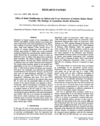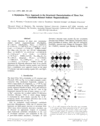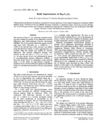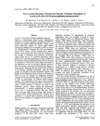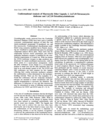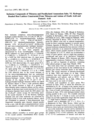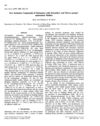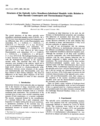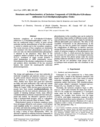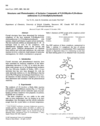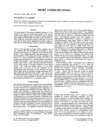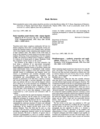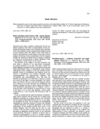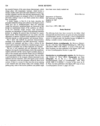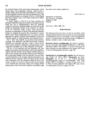issue contents
April 1997 issue

Cover illustration: Contoured distribution of hydrogen bonds from N-H and O-H donors about the oxygen acceptors of the disulfate dianion. Data for the 232 hydrogen bonds (O...H > 2.62 Å) were computed from the Cambridge Structural Database and the required symmetry was applied to generate the final distribution. Courtesy of M. Verdonk and J. Cole
research papers
The mixed crystals of the isomorphous salts NaClO3 and NaBrO3 were reinvestigated by X-ray diffraction. The noncubic structures that were determined address long-standing observations of anomalous birefringence in these materials.
Download citation


Download citation


The crystal structures of three new cristobalite-related sodium magnesiosilicates are determined by Rietveld refinement from X-ray powder diffraction data. Good starting models for the structures were obtained prior to refinement via a modulation wave approach based on the ideal C9 cristobalite structure type and assuming regular SiO4 and MgO4 tetrahedra.
Download citation


Download citation


The structure of Sb0.9V1.1O4, which presents a new rutile superstructure, is determined by means of powder X-ray diffraction, electron diffraction and high-resolution electron microscopy techniques.
Download citation


Download citation


The crystal structures of the title compound at 295 and 103K show a space group difference, which gives insight into the thermotropic transition to the liquid crystal mesophase. The 103K structure was determined to high precision, using SR and a CCD detector.
Results from the Cambridge Structural Database have been used to perform conformational analyses on free and metal- coordinated 12-membered oxa and thia macrocycles. Conformational classifications established using symmetry-modified Jarvis–Patrick clustering are visualized in conformational space by principal component analysis plots.
Download citation


Download citation


In the crystal structure of tetra-n-butylammonium hydrogen oxalate–thiourea (1/2) the quaternary ammonium ions are sandwiched between puckered layers, which are constructed from thiourea–hydrogen oxalate ribbons. Three thiourea–quaternary ammonium fumarate (or hydrogen fumarate) complexes exhibit thiourea–anion lattices which are distinctly different from one another, depending on the stoichiometries and the presence of co-crystallized water molecules.
Download citation


Download citation


New inclusion compounds are described: (C2H5)4NCl.2[(NH2)2CSe] has a layer-type selenourea-chloride host structure, isomorphous (n-C3H7)4NX.3[(NH2)2CSe] (X = Cl, Br) feature an open-channel network constructed from wide seleno-urea-halide ribbons and (n-C3H7)4NI.3[(NH2)2CSe] is characterized by a composite ribbon composed of a zigzag arrangement of selenourea molecules with iodide ions attached to both sides.
Download citation


Download citation


The title compounds are ferroelastic. Some hydrogens in the structure are involved in asymmetric hydrogen bridges, which hop between the donor and acceptor oxygens during ferroelastic switching.
Download citation


Download citation


The hydrogen-bonding pattern in the crystal structures of the three optically active monofluoromandelic acids are compared internally and with those observed in their racemic analogues. The differences in the intermolecular interactions are related to the different appearance of the binary phase diagrams of the three acids.
Download citation


Download citation


The crystal structures of four inclusion complexes are deter- mined and correlated with their photochemical reactivity; three of the complexes crystallize in a chiral space group and irradiation of single crystals produces chiral photoproducts.
Download citation


Download citation


Crystal structures have been determined for inclusion complexes of the host molecule 9,10-dihydro-9,10-ethenoanthracene- 11,12-bis(diphenylmethanol), with acetone, ethanol and toluene as guest solvent molecules. Different photoproducts are obtained from solution and solid-state photolyses; the solid-state reaction involves a relatively small amount of molecular rearrangement, for which a mechanism is proposed.
Download citation


Download citation


Three new crystal structures of 2,4-dinitrobenzylpyridine derivatives reveal the correlation between their photoactivity and the π–π interactions between the 2,4-dinitrophenyl group and other neighboring aromatic rings.
short communications
Download citation


Download citation


Approximately 10% of the structures listed in the Cambridge Structural Database as belonging to space group Cc are better described in other space groups, usually C2/c. Revised space groups, cell dimensions (where necessary) and atom coordinates have been derived for 98 such entries.
CCDC references: 1102584; 1110652; 1114040; 1115386; 1117537; 1119212; 1120637; 1124607; 1126434; 1127463; 1131320; 1131975; 1132053; 1134087; 1136801; 1136874; 1136876; 1138627; 1139057; 1139233; 1140954; 1141394; 1141595; 1141597; 1141666; 1143631; 1144555; 1146661; 1147514; 1153024; 1157537; 1162265; 1165397; 1165570; 1171506; 1171888; 1172920; 1180419; 1181431; 1182050; 1182587; 1184123; 1185255; 1187112; 1188292; 1188319; 1191526; 1193614; 1195130; 1195594; 1195837; 1195919; 1196198; 1196374; 1196436; 1196438; 1197113; 1197891; 1198031; 1198111; 1199809; 1200323; 1205334; 1206237; 1206497; 1222336; 1223310; 1225611; 1225732; 1226448; 1227496; 1230525; 1230875; 1230877; 1231150; 1233515; 1255868; 1255925; 1257116; 1258161; 1259264; 1259348; 1259890; 1260193; 1261851; 1262574; 1266553; 1280608; 1282574; 1283364; 1285595; 1288137; 1289757; 1292381; 1298346; 1298977; 1302207; 1302632
book reviews
Free 

Free 

books received
Free 

Free 



 journal menu
journal menu









